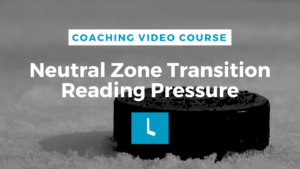(Transcribed from How to Play Hockey: Our Minor Hockey Coaching Course.)
The next type of entry is “dumping it in” or “chipping it in”. Let’s say we have a lot of tight pressure on us, and we feel that we need to get rid of the puck and get it down below their goal line to a low risk area. The opposing D have done a great job holding the blue line. We have backside pressure, they have defensive support. They have a C coming hard through the middle, and we know against this particularly skilled D that we can’t beat him/her 1-on-1, we’re probably going to be forced to dump it in.
[maxbutton id=”2″ ]
Often I see players dump it in without a purpose. If you dump it with a purpose I prefer to call it an indirect pass than a dump. We have three main options when making this play…
Cross Corner Dump
- F1 is carrying the puck through the middle of the ice.
- We know we can’t beat their defensemen 1-on-1, but we know we have wall support from our F2, so we put it through the D and we get to sit down in the corner far away so that their goalie is unlikely to go and get it.
- NOT sitting behind the net where they can retrieve it.
- Instead we go across corner and that causes the opposing D, who’s going backwards, to be very fleet of foot to turn and go get that puck before this opposing player gets it.
That’s why I personally like to call that an indirect pass because I’m not getting rid of it. I’m getting it to this winger via the end of boards cross ice dump.
Soft Chip
- If I am the F1 puck carrier and I have middle lane support instead of just throwing it all the way down to the corner, I make a soft chip behind the opposing D for our F2 to retrieve in the half wall area.
- If the opposing D has a bad angle on me or is flat footed I can put the puck in behind this that D and I can go around him/her to get it.
Again this type of play has a purpose behind it. I’m trying to get to it indirectly by using the boards. I don’t try to put it through the opposing D. That’s too risky.
Hard Rim
The last one you’ll see in a lot of high levels of hockey on a powerplay entry where the defensive team is doing a good job holding their blue line and that’s called the ‘Hard Rim’.
- F1 is driving driving wide with speed and recognizes he/she has no direct pass option as the opposing D begins to close in.
- So we use an indirect hard rim all the way around the boards and our goal is for our weak side F2/F3 to go and retrieve around the hash area.
Some common mistakes I see is somebody using a hard rim when their F2/F3 are coming over towards them to support a soft area play or shot on net. Some nonverbal communication between the F1 and supporting FWD’s needs to happen. You need to be able to anticipate and the same applies for that cross ice dump. If you don’t have weak side pressure, it’s going to be a easy puck turn over.
Remember that if you have to dump it, dump it with a purpose and consider it an indirect pass rather than a dump in give away. Enter with possession when you can and dump in only when you must.
That is a neutral zone to offensive zone entry and we’ll explore more of that entry and what happens next in the next module.
Thanks for watching! See you in the next video!
Looking to download half ice hockey practice plans, goalie drills for teams (not a goalie coach?!) or small area games drills? We’ve got you covered too. Click here. Perfect for recreational level coaches.





